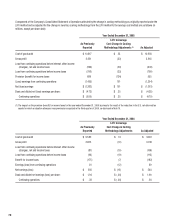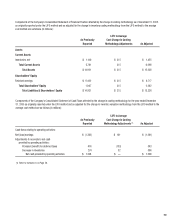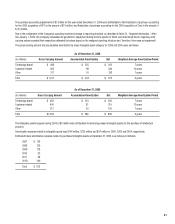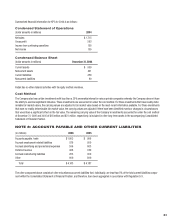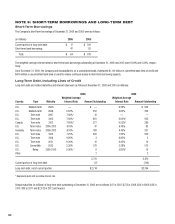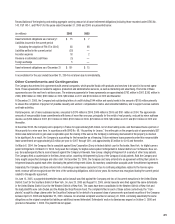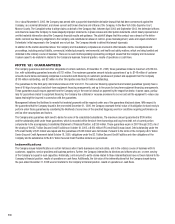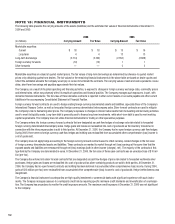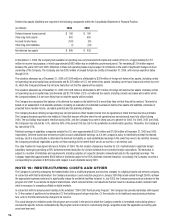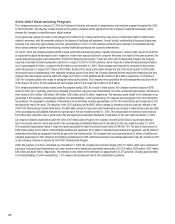Kodak 2006 Annual Report Download - page 95
Download and view the complete annual report
Please find page 95 of the 2006 Kodak annual report below. You can navigate through the pages in the report by either clicking on the pages listed below, or by using the keyword search tool below to find specific information within the annual report.
The Company has retained certain obligations for environmental remediation and Superfund matters related to certain sites associated with the non-
imaging health businesses sold in 1994. At December 31, 2006, estimated future remediation costs of $21 million are accrued for these sites and are
included in the $154 million reported in other long-term liabilities.
Cash expenditures for the aforementioned investigation, remediation and monitoring activities are expected to be incurred over the next twenty-nine
years for many of the sites. For these known environmental liabilities, the accrual reflects the Company’s best estimate of the amount it will incur un-
der the agreed-upon or proposed work plans. The Company’s cost estimates were determined using the ASTM Standard E 2137-01, “Standard Guide
for Estimating Monetary Costs and Liabilities for Environmental Matters,” and have not been reduced by possible recoveries from third parties. The
overall method includes the use of a probabilistic model which forecasts a range of cost estimates for the remediation required at individual sites. The
projects are closely monitored and the models are reviewed as significant events occur or at least once per year. The Company’s estimate includes
equipment and operating costs for remediation and long-term monitoring of the sites. The Company does not believe it is reasonably possible that the
losses for the known exposures could exceed the current accruals by material amounts.
A Consent Decree was signed in 1994 in settlement of a civil complaint brought by the U.S. Environmental Protection Agency and the U.S. Department
of Justice. In connection with the Consent Decree, the Company is subject to a Compliance Schedule, under which the Company has improved its
waste characterization procedures, upgraded one of its incinerators, and is evaluating and upgrading its industrial sewer system. The total expen-
ditures required to complete this program are currently estimated to be approximately $2 million over the next two years. These expenditures are
incurred as part of plant operations and, therefore, are not included in the environmental accrual at December 31, 2006.
The Company is presently designated as a potentially responsible party (PRP) under the Comprehensive Environmental Response, Compensation and
Liability Act of 1980, as amended (the Superfund Law), or under similar state laws, for environmental assessment and cleanup costs as the result of
the Company’s alleged arrangements for disposal of hazardous substances at six Superfund sites. With respect to each of these sites, the Company’s
liability is minimal. In addition, the Company has been identified as a PRP in connection with the non-imaging health businesses in three active
Superfund sites. Numerous other PRPs have also been designated at these sites. Although the law imposes joint and several liability on PRPs, the
Company’s historical experience demonstrates that these costs are shared with other PRPs. Settlements and costs paid by the Company in Superfund
matters to date have not been material. Future costs are also not expected to be material to the Company’s financial position, results of operations or
cash flows.
The Clean Air Act Amendments were enacted in 1990. Expenditures to comply with the Clean Air Act implementing regulations issued to date have not
been material and have been primarily capital in nature. In addition, future expenditures for existing regulations, which are primarily capital in nature,
are not expected to be material. Many of the regulations to be promulgated pursuant to this Act have not been issued.
Uncertainties associated with environmental remediation contingencies are pervasive and often result in wide ranges of outcomes. Estimates devel-
oped in the early stages of remediation can vary significantly. A finite estimate of costs does not normally become fixed and determinable at a specific
time. Rather, the costs associated with environmental remediation become estimable over a continuum of events and activities that help to frame and
define a liability, and the Company continually updates its cost estimates. The Company has an ongoing monitoring and identification process to as-
sess how the activities, with respect to the known exposures, are progressing against the accrued cost estimates, as well as to identify other potential
remediation sites that are presently unknown.
Estimates of the amount and timing of future costs of environmental remediation requirements are by their nature imprecise because of the continuing
evolution of environmental laws and regulatory requirements, the availability and application of technology, the identification of presently unknown
remediation sites and the allocation of costs among the potentially responsible parties. Based upon information presently available, such future costs
are not expected to have a material effect on the Company’s competitive or financial position. However, such costs could be material to results of
operations in a particular future quarter or year.
Asset Retirement Obligations
As of December 31, 2006 and 2005, the Company has recorded approximately $101 million and $75 million, respectively, of asset retirement obliga-
tions within other long-term liabilities in the accompanying Consolidated Statement of Financial Position. The Company’s asset retirement obligations
primarily relate to asbestos contained in buildings that the Company owns. In many of the countries in which the Company operates, environmental
regulations exist that require the Company to handle and dispose of asbestos in a special manner if a building undergoes major renovations or is
demolished. Otherwise, the Company is not required to remove the asbestos from its buildings. The Company records a liability equal to the estimated
fair value of its obligation to perform asset retirement activities related to the asbestos, computed using an expected present value technique, when
sufficient information exists to calculate the fair value. The Company does not have a liability recorded related to each building that contains asbestos
because the Company cannot estimate the fair value of its obligation for certain buildings due to a lack of sufficient information about the range of
time over which the obligation may be settled through demolition, renovation or sale of the building.


